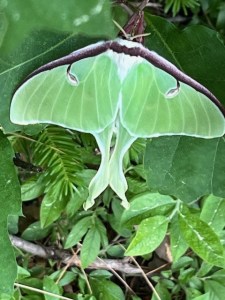
What a surprise I had a little after dawn. I am down by the brook checking on ripening berries, and I discover another luna moth on this morning of July’s Berry Moon. This one is lying dead on a pine log. The last one I found was on the road in June on a morning walk. It’s past luna season, I think, as nature contradicts me. When I bent down to pick up the lime green three-inch-wide insect with its double set of eyes, I notice how torn and tattered its wings are, probably a result of a would-be predator that discovered too late how unpleasant these moths can taste. Or perhaps it was just old age. This one had short feathery antenna; she was a female.
In the past, a second sight of one of these deceased moths would have made me sad because I am aware that when Luna reaches the moth stage s/he is birthed without a mouth to eat, and as soon as the insect mates luna dies. Today I can accept that these moths have lived full lives. As an adult this one has mated and laid eggs that one day will hatch and new life will begin. Nature’s endless round is comforting to observe, as well as to reflect upon. Every creature has her/his season.
These moths have interesting strategies for defense. As larvae they click warnings. They also regurgitate intestinal contents that have a deterrent effect on a variety of predators. The startling double set of eyes on the pale green adult wings are believed to confuse predators but I am not sure why. The elongated tails of the hindwings are believed to jam echolocation used by predatory bats, although I hardly think bats are a problem around here; I see so few.
I brought this moth in the house to look at, more closely wondering again just where around here on the ground the larva had hatched into its adult form. Females lay 200–400 eggs, singly or in small groups, on the underside of leaves. Egg laying starts the evening after mating is completed and goes on for several days. Eggs hatch in about a week.
Each instar – the period between molts – generally takes about 4–10 days. There are fiveninstars before cocooning occurs. At the end of each instar, a small amount of silk is placed on the major vein of a leaf and the larva molts, leaving its green exoskeleton behind. After the final instar, larvae stay on the same tree where they hatched until it is time to descend to the ground to make a cocoon. (Around here birches are probably the most common tree that Luna uses) At this point the caterpillar will spin its cocoon around a shriveled leaf that is lying on the ground. A very good reason to leave leaf litter where it falls whenever possible. When females emerge from cocoons, they fly to a tree, emit pheromones, and wait there for males to find them. Males can detect these molecules from several miles away. Each fly into the wind until the female is found. Luna moth females’ mate with the first males to find them, a process that typically starts after midnight and takes several hours, as previously mentioned. The entire Luna Moth cycle usually occurs in the space of one year. In the North Country one generation of moths is produced.
Luna moths are what are known as giant silk moths – some have wingspans of seven inches. This moth was the first to be recorded in American insect literature. These magnificent creatures have a range that extends from Canada to Florida, and like every other insect, this moth is succumbing to habitation loss, pesticides, logging, light pollution and a myriad of other problems associated with a rapidly warming climate. I used to see Luna each summer but these days as a rule I find one rarely. This year has been an exception. I’ll never forget the summer one fell out of the sky onto my head while I was standing on the porch of my little camp!
For me personally, the sight of even one, living or dead, is a gift to be treasured and written about.